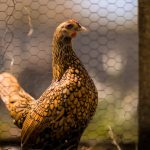Understanding the threat of potential predators is crucial in securing a coop and protecting the flock. Predators come in various forms, including mammals, birds, and reptiles. Mammalian predators such as foxes, raccoons, and weasels are known for their cunning and agility, making them a significant threat to poultry.
Birds of prey, such as hawks and owls, pose a danger to free-ranging chickens. Snakes, particularly rat snakes and black snakes, are also known to prey on eggs and chicks. It is essential to research the specific predators in your area to understand their behavior and habits.
By understanding the threat, you can better prepare and implement effective strategies to protect your coop and flock. Furthermore, it is important to recognize that predators are opportunistic and will take advantage of any vulnerabilities in the coop’s security. They are adept at finding weaknesses in fencing, coops, and other structures.
Predators are also known to be persistent, often returning to the same location in search of an easy meal. Understanding the threat means acknowledging the intelligence and determination of predators and taking proactive measures to prevent them from accessing the coop. By understanding the threat, coop owners can develop a comprehensive plan to secure their coop and protect their flock from potential harm.
Table of Contents
- 1 Securing the Coop
- 2 Using Deterrents
- 3 Implementing Scare Tactics
- 4 Removing Attractants
- 5 Seeking Professional Help
- 6 Monitoring and Maintenance
- 7 FAQs
- 7.1 What are some common animals that pose a threat to chickens?
- 7.2 How can I keep predators away from my chickens?
- 7.3 What are some natural deterrents for keeping animals away from chickens?
- 7.4 Are there any non-lethal methods for keeping animals away from chickens?
- 7.5 What should I do if I spot a predator near my chickens?
Key Takeaways
- Understanding the threat: Recognize the potential risks and vulnerabilities to your coop, such as predators and pests.
- Securing the coop: Invest in high-quality locks, sturdy fencing, and predator-proofing measures to keep your coop safe.
- Using deterrents: Utilize motion-activated lights, sound devices, and predator decoys to deter potential threats.
- Implementing scare tactics: Consider using visual scare tactics like scarecrows or reflective tape to keep predators away from your coop.
- Removing attractants: Keep the area around the coop clean and free of food sources to reduce the likelihood of attracting predators.
- Seeking professional help: Consult with experts or professionals for advice on additional security measures and best practices for coop protection.
- Monitoring and maintenance: Regularly inspect and maintain the security measures in place to ensure the ongoing safety of your coop.
Securing the Coop
Predator-Proof Fencing
One of the primary steps in securing the coop is to ensure that the fencing is predator-proof. This may involve burying wire mesh underground to prevent digging predators from gaining access to the coop. Regular inspections of the fencing are also necessary to identify any signs of wear or damage that could compromise its integrity.
Protecting from Aerial Predators
Coop owners should consider adding a roof or netting over the top of the enclosure to prevent aerial predators from swooping in and attacking the flock.
Fortifying the Coop
In addition to securing the fencing, coop owners should focus on fortifying the coop itself. This may involve reinforcing doors and windows with heavy-duty locks and latches to prevent predators from forcing their way inside. It is also essential to inspect the coop for any gaps or openings that could allow predators to enter. Sealing any potential entry points with hardware cloth or other sturdy materials can prevent unauthorized access.
Using Deterrents

Using deterrents is an effective strategy for deterring potential predators from targeting the coop and flock. There are various types of deterrents that can be used to discourage predators from approaching the coop. Visual deterrents, such as scarecrows, reflective tape, or predator decoys, can be effective in deterring predators by creating the illusion of a threat.
These visual deterrents can disrupt the predator’s hunting patterns and make them think twice before approaching the coop. Another type of deterrent is auditory deterrents, such as motion-activated alarms or radios playing loud noises. These deterrents can startle predators and make them hesitant to approach the coop.
Additionally, scent deterrents, such as predator urine or strong-smelling plants, can be used to create a barrier around the coop and deter predators from getting too close. By using a combination of visual, auditory, and scent deterrents, coop owners can create a hostile environment for potential predators, reducing the likelihood of an attack on the flock.
Implementing Scare Tactics
Implementing scare tactics is another effective way to deter potential predators from targeting the coop and flock. Scare tactics involve creating a sense of fear or unease in predators to discourage them from approaching the coop. One common scare tactic is using motion-activated lights or sound devices that startle predators when they approach the coop.
These sudden bursts of light or noise can disrupt a predator’s hunting behavior and make them think twice before attempting an attack. Another scare tactic is using visual deterrents such as scarecrows or predator decoys that mimic the appearance of a larger, more threatening animal. These visual deterrents can create a sense of danger for predators and deter them from approaching the coop.
Additionally, some coop owners use guard animals such as dogs or geese to patrol the area around the coop and deter potential predators. These animals can act as a natural deterrent by alerting the flock to potential threats and intimidating predators with their presence.
Removing Attractants
Removing attractants from the vicinity of the coop is essential in minimizing the risk of predator attacks. Predators are drawn to areas where food sources are readily available, so it is important to eliminate any potential attractants that could entice them to approach the coop. This may involve securing garbage cans, compost piles, and pet food storage to prevent scavenging predators from being drawn to the area.
Coop owners should also be mindful of any fallen fruit or bird feeders that could attract predators looking for an easy meal. Additionally, it is important to keep the area around the coop clear of tall grasses, shrubs, and debris that could provide cover for predators stalking their prey. By removing potential attractants from the vicinity of the coop, coop owners can reduce the likelihood of predator attacks and create a less appealing environment for potential threats.
Seeking Professional Help

Conducting a Thorough Assessment
Professional wildlife experts or pest control specialists can conduct a thorough assessment of the property to identify potential entry points, attractants, and other factors that may be contributing to predator issues. This assessment can help identify areas that need improvement and inform the development of effective strategies for deterring and managing predators.
Implementing Advanced Deterrents and Securing Equipment
In some cases, professional help may be necessary to implement more advanced deterrents or secure specialized equipment to protect the coop and flock. Wildlife experts can provide guidance on the most effective deterrents and equipment for specific predator species and can assist in installing and maintaining these systems.
Ensuring Humane and Legal Predator Control
Wildlife experts can also provide guidance on legal and ethical considerations when dealing with predator issues, ensuring that all measures taken are humane and in compliance with local regulations. This is particularly important when dealing with protected species or in areas with specific regulations governing predator control.
Monitoring and Maintenance
Monitoring and maintenance are crucial in ensuring that the coop remains secure and protected from potential predators over time. Coop owners should regularly inspect the fencing, doors, windows, and other structures for any signs of wear or damage that could compromise security. It is important to address any issues promptly to prevent predators from exploiting vulnerabilities in the coop’s defenses.
Additionally, coop owners should remain vigilant in monitoring for signs of predator activity around the coop, such as tracks, scat, or evidence of attempted entry. By staying alert and proactive in monitoring for potential threats, coop owners can take swift action to address any emerging issues before they escalate into a serious problem. In conclusion, understanding the threat of potential predators is essential in securing a coop and protecting the flock from harm.
By implementing effective strategies such as securing the coop, using deterrents, implementing scare tactics, removing attractants, seeking professional help, and maintaining vigilance through monitoring and maintenance, coop owners can create a safe and protected environment for their flock. With careful planning and proactive measures, coop owners can minimize the risk of predator attacks and ensure the safety and well-being of their poultry.
If you’re looking for more tips on keeping your chickens safe, you might want to check out this article on renting a chicken coop. It offers valuable information on providing a secure and comfortable living space for your chickens, which can help keep them safe from predators.
FAQs
What are some common animals that pose a threat to chickens?
Some common animals that pose a threat to chickens include foxes, raccoons, coyotes, dogs, cats, hawks, and owls.
How can I keep predators away from my chickens?
There are several methods to keep predators away from chickens, including using fencing, predator-proofing the coop, using guard animals such as dogs or llamas, and using motion-activated lights or sound deterrents.
What are some natural deterrents for keeping animals away from chickens?
Some natural deterrents for keeping animals away from chickens include planting strong-smelling herbs and flowers around the coop, using predator urine or predator scent deterrents, and keeping the area clean and free of food scraps.
Are there any non-lethal methods for keeping animals away from chickens?
Yes, there are non-lethal methods for keeping animals away from chickens, such as using scare tactics like scarecrows or reflective tape, using motion-activated sprinklers, and using netting or wire mesh to protect the chickens.
What should I do if I spot a predator near my chickens?
If you spot a predator near your chickens, it’s important to act quickly to scare the predator away. You can make loud noises, use a flashlight, or even throw objects in the direction of the predator to scare it off. It’s important to ensure the safety of your chickens while doing so.
Meet Walter, the feathered-friend fanatic of Florida! Nestled in the sunshine state, Walter struts through life with his feathered companions, clucking his way to happiness. With a coop that’s fancier than a five-star hotel, he’s the Don Juan of the chicken world. When he’s not teaching his hens to do the cha-cha, you’ll find him in a heated debate with his prized rooster, Sir Clucks-a-Lot. Walter’s poultry passion is no yolk; he’s the sunny-side-up guy you never knew you needed in your flock of friends!







